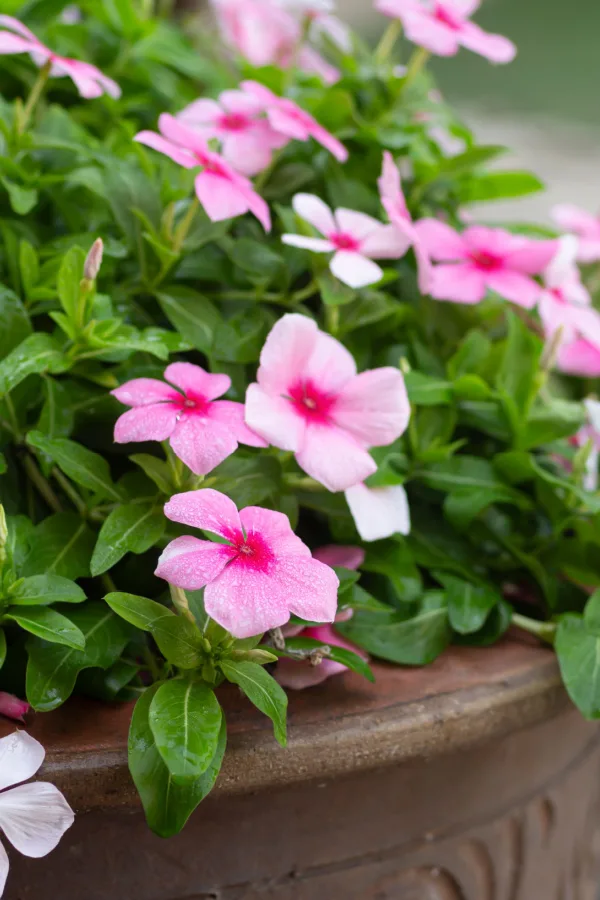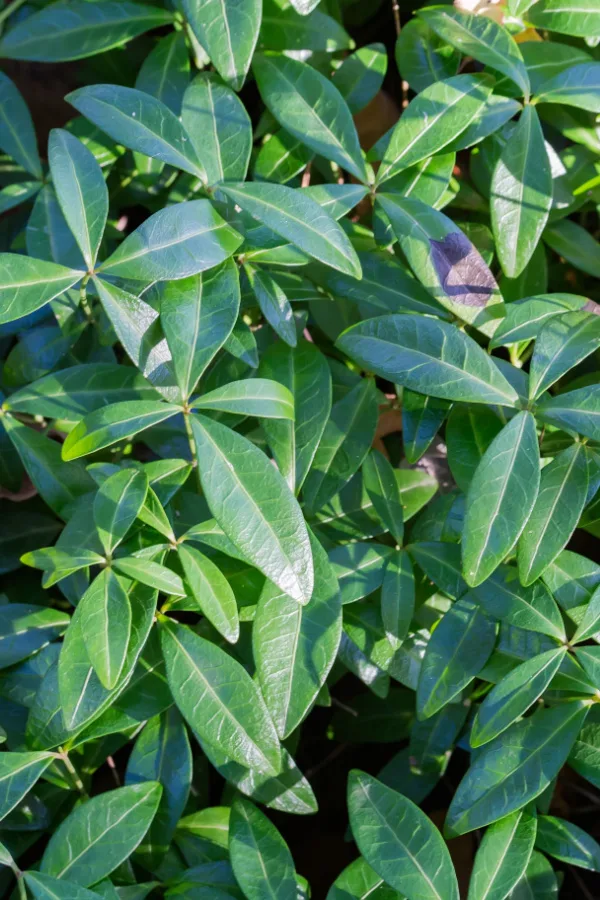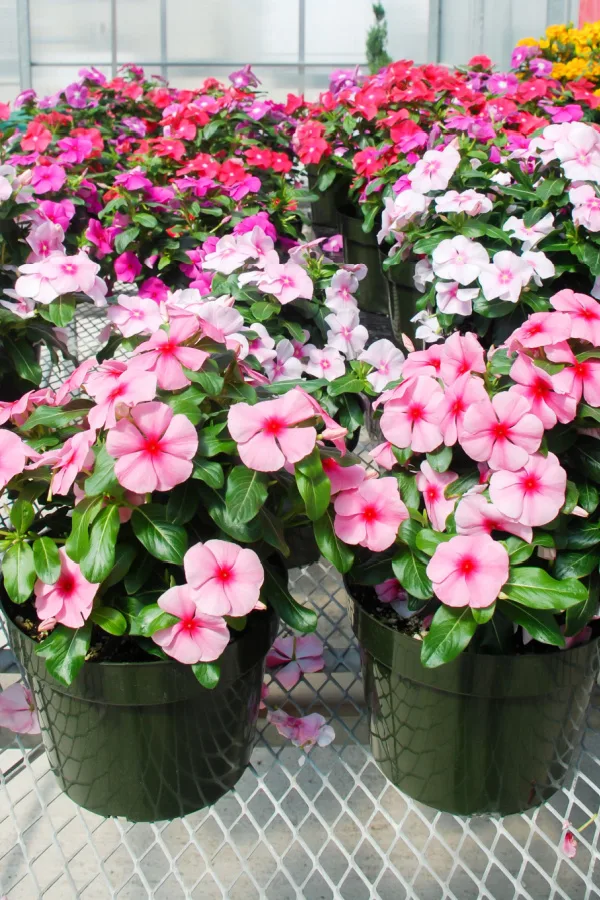If you want a plant that can really take the heat of summer and still provide you with beautiful foliage and limitless blooms, then you need to grow vinca. Not only is it incredible for adding lasting summer color to your flowerbeds, it’s perfect for hanging baskets and containers too!
Vinca, often known as periwinkle, has blooms and foliage that closely resemble impatiens. But whereas impatiens love cooler and shadier areas – vinca thrives in full sunlight. In fact, they flourish in almost any sunny, dry, and warm location.
That love for heat and sun is exactly what makes vinca such a great choice for the hot & sunny areas of your home where many plants wither away once summer arrives!

There are many different varieties available to fit almost any planting need. Some vinca plants grow as small as 6 inches tall and have very compact root systems, making them perfect for window boxes and small pots on sun-drenched patios.
But if you are looking for big flower power for your flowerbeds, other types of vinca can grow as large as 18 inches! Some varieties grow more upright and are great for raised beds or garden spaces. Others have more of a trailing, ground cover habit. These types work great for accents in hanging baskets or container displays.
No matter what the variety, the flowering annual features colorful blooms with shiny foliage that is attractive even when the plants are not in bloom. And because vinca is so drought and heat-resistant, it also helps to cut down on your summer watering chores too!
How To Plant, Grow, And Maintain Vinca
Most vinca varieties can be found with blooms in red, pink, white or purple. Once vinca starts blooming in late spring, with minimal care, it will keep on flowering all the way up until the first frost. Although they are actually hardy in zones 9 through 11, they grow as annuals in all other zones.

In addition to their toughness to heat and sun, vinca also happen to be great pollinator plants. They are wonderful for bringing in bees, butterflies and even hummingbirds. If that was enough, they also are highly resistant to deer and rabbits!
How To Plant & Grow Vinca
Vinca can be started from seed, but it can be a bit tricky when it comes to germination. They also take a long time to develop and mature (10 to 12 weeks compared to 6 to 8 weeks for most other flowering annuals) to be ready for transplanting.
Because of this, it is usually far better to purchase ready to go transplants at local nurseries or greenhouses. Not only are they usually already blooming, they are extremely easy to get established.
Begin by selecting a location that receives full sun. Remember that vinca love light and heat, so it is best to plant them where they will receive at least 6 to 8 hours of sunlight. Ideally, plant them where they will get mid-day sun as it is the brightest and hottest.
Amending The Soil Before Planting
More than anything else, for vinca, the soil needs to be well draining. If planting into flowerbeds, amend the soil in your planting hole with compost and/or worm castings. These will help add valuable nutrients, and create a more loose soil to help shed excess water. If your soil happens to heavy and clay-like, adding a bit of sand can be beneficial for drainage as well.

When planting in pots and containers, traditional potting soil works best. Not only does it have plenty of nutrients for good growth, it also is lightweight and drains well, which will vinca from becoming too
Whether planting in flowerbeds or pots, plant transplants so that the soil surface of the transplant is equal to the surrounding soil. Burying the stems too deep can cause the plants to rot out if there is too much moisture.
Spacing will depend on the variety, so always read carefully to space appropriately. Although some vinca stay quite small, other varieties can spread from a half foot to three feet wide.
Long-Term Care – How To Grow and Maintain Vinca
One of the best qualities of vinca is that even though it is a flowering annual, it requires very little maintenance throughout the growing season. As long as a few basic needs are met, the tough-as-nails plant will reward you continual flowering.
Watering
Over-watering is often more of an issue than underwatering when it comes to annual vinca. Only water if the plants are not receiving regular weekly rainfall. Vinca will perform much better in somewhat dryer conditions as opposed to overly saturated soils.
Fertilizing
Since they are not heavy feeders, vinca will thrive without a lot of additional nutrients. Adding in a little bit of compost and/or worm castings to their planting hole will get plants off to a great start. Affiliate Product Link : 100% Pure Worm Castings
When growing vinca in pots or containers, a dose of liquid or slow-release granular fertilizer once a month is more than enough to keep plants strong, healthy and blooming. Compost tea is also an excellent organic alternative to commercial fertilizers for fertilizing vinca.
Deadheading & Pruning
Another great feature of vinca is that they do not require deadheading to continue to bloom. The plants uses such little energy to grow and produce, fading blooms do not compete with new flowers coming on.

Vinca is also fairly disease resistant as well. In overly wet conditions, leaf spot and blight can sometimes occur. These issues usually happen because of the lack of proper airflow and moist conditions. If that is the case, pruning might be beneficial to help thin plants out and allow for better air circulation.
Follow Our Facebook Page For Even More Great Tips! Simple Garden Life Facebook Page
Simple Garden Life is a website dedicated to keeping gardening fun, simple and enjoyable! We publish two new articles each week along with a new garden podcast episode every two weeks. This article may contain affiliate links.
Feel free to download, print out, or save our Vinca At-A-Glance sheet. It is sized for half letter printing but can be scaled if needed.
